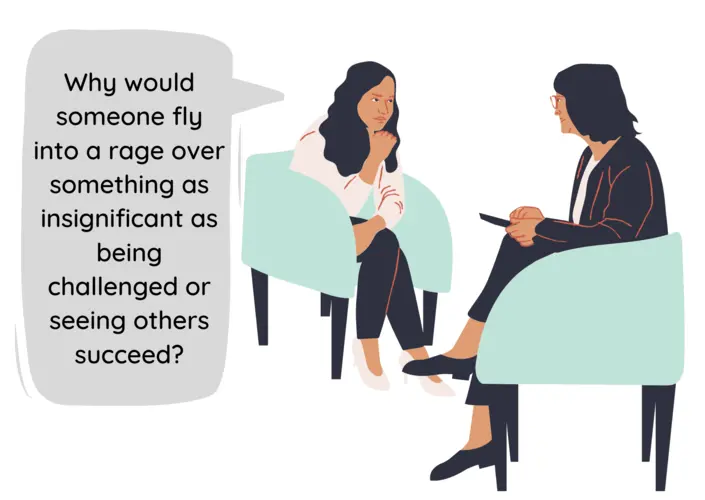A common question many people have once they learn more about narcissism and narcissistic abuse is, “What exactly is narcissistic rage?”
Narcissistic rage is a reaction that emerges when someone with narcissistic tendencies perceives a threat to their self-esteem or self-worth. It can manifest in various ways, from cold, passive-aggressive retaliation to explosive anger.
In this article, I will guide you through the causes, signs, and types of narcissistic rage, giving you a complete guide to this important topic.
Part 1: Understanding What Causes Narcissistic Rage
I previously stated, “Narcissistic rage is a reaction that emerges when someone with narcissistic tendencies perceives a threat to their self-esteem or self-worth.”
The key part of this statement is “a threat to their self-esteem or self-worth” because it is the cause of narcissistic rage and is commonly referred to as a narcissistic injury.
Now, I know all of this can sound like mumbo jumbo, especially if this is your first time learning about it. But narcissistic injuries are essentially emotional wounds.
However, we don’t call them emotional wounds because, unlike typical emotional wounds that may arise from direct harm or mistreatment, narcissistic injuries can stem from even the slightest challenge of a narcissist’s self-image.
For example:
- Not receiving the expected praise or acknowledgment.
- Being contradicted or disagreed with in public settings.
- Witnessing someone else receive attention or accolades.
- Experiencing failure or defeat, even in minor instances.
- Being challenged or questioned about their knowledge or expertise.
- Perceived slights in personal relationships, like feeling ignored or undervalued.
Suggested Reading: What Causes Narcissistic Injuries?
Alright, now that you understand what causes narcissistic rage, let’s dive a bit deeper to understand better why narcissistic rage occurs.
So you might be thinking, “Why would someone fly into a rage over something as insignificant as being challenged or seeing others succeed?”

Well, narcissists struggle with many thoughts, feelings, and emotions. Behind their grandiosity lies someone who feels unlovable, inadequate, worthless, and weak.
The problem is that they don’t have the emotional skills to manage these painful thoughts, feelings, and emotions through healthy regulation.
Instead, they accumulate as much narcissistic supply as possible to suppress these thoughts, feelings, and emotions so they can construct a positive self-perception.
Suggested Reading: What Is Narcissistic Supply?
In a perfect world, this strategy would work.
But the reality of the situation is that narcissists can’t keep their painful thoughts, feelings, and emotions suppressed.
With a consistent supply flow, narcissists can maintain a positive self-image.
But because these thoughts, feelings, and emotions are always beneath the surface, narcissists develop extremely fragile egos that get damaged by even the slightest challenge of a narcissist’s self-image.
When they experience a challenge to their positive self-image, their painful thoughts, feelings, and emotions rush to their surface, reminding them of how unlovable, unwanted, inadequate, worthless, and weak they feel.
As you can imagine, this causes tremendous psychological tension and emotional turmoil that, again, narcissists don’t have the skills to manage healthily.
So, what do they do?
They rage because they don’t know how to express themselves, similar to how young children throw temper tantrums when they struggle to express themselves.
Part 2: Spotting the Signs of Narcissistic Rage
Recognizing the signs of narcissistic rage is crucial for understanding and navigating interactions with someone exhibiting this behavior.
Here are the primary indicators:
1.) Sudden Mood Swings: Rapid transitions from calm or charm to anger highlight the instability of emotional regulation, signaling a strong indication of narcissistic rage.
2.) Heightened Defensiveness: When defensiveness, especially in the face of feedback or minor criticism, is paired with blame-shifting, it’s a sign of narcissistic rage.
3.) Overreaction to Criticism: A disproportionate reaction to minor disagreements or critiques is a glaring indicator of underlying narcissistic rage.
4.) Intense Jealousy: The inability to bear others being praised or succeeding, to the point of overt resentment, reveals deep-seated narcissistic rage.

5.) Difficulty Accepting No: An aggressive or extremely negative reaction when wishes aren’t met showcases the inherent rage of a narcissistic personality.
6.) Exaggerated Self-importance: Feeling slighted or reacting negatively when not the center of attention is a manifestation of narcissistic rage.
7.) Volatile Relationships: Patterns of intense conflicts over perceived offenses, especially with close acquaintances, are telltale signs of simmering narcissistic rage.
8.) Physical Symptoms: Observable signs like flushing, pacing, or fist-clenching during moments of anger are physical manifestations of deep-rooted narcissistic rage.
Part 3: The Different Types of Narcissistic Rage
Narcissistic rage isn’t one-size-fits-all.
Depending on the individual and the situation, it can vary in intensity and expression.
Recognizing the different types of rage can be instrumental in understanding the multifaceted nature of this emotional response.
1.) Explosive Rage
This type is the most overt form of narcissistic rage.
It is characterized by intense and often uncontrollable outbursts.
When a narcissist experiences explosive rage, their emotions erupt in a loud and potentially violent manner.
Suggested Reading: How to Know if a Narcissist Will Kill You
Their anger, once triggered, can be verbal, with aggressive shouting, or even physical, leading to situations that can become threatening for those around them.
The abruptness and ferocity of these episodes can be jarring, especially since they might be set off by events that many would consider minor provocations.
2.) Passive-Aggressive Rage
Unlike its explosive counterpart, passive-aggressive rage is covert and subtle.
Those exhibiting this type of rage express their anger through behaviors designed to hurt or irritate without engaging in direct confrontation.
A narcissist in this state might resort to tactics like the silent treatment, backhanded compliments, or deliberately neglecting duties or responsibilities to make a point.
The insidious nature of passive-aggressive rage means it’s often used as a means of control or punishment, making you feel uncertain, guilty, or anxious.
3.) Cold Withdrawal
Another covert form of rage, cold withdrawal, sees the narcissist leveraging emotional distance as a weapon.
Opting for this approach, the narcissist seeks to induce feelings of rejection, anxiety, or unimportance in their target.

It’s a calculated form of punishment where the narcissist emotionally detaches themselves, refusing to communicate or engage, leaving their target feeling isolated.
This icy demeanor can be particularly hurtful for those seeking resolution or understanding, as the narcissist’s withdrawal is often both sudden and prolonged.
4.) Manipulative Rage
This type is particularly strategic.
When narcissists employ manipulative rage, they use their anger or the threat of it to manipulate situations or people to their advantage.
It can manifest in various ways, such as self-victimization, guilt-tripping, or tactics like gaslighting to create doubt and confusion.
This type of rage is about control and can be especially damaging, as it often leaves you questioning your perceptions, memories, or even your sanity.
5.) Vindictive Rage
Rooted in a sense of being wronged, vindictive rage involves a calculated and prolonged desire for revenge.
When in the grip of this rage, the narcissist feels deeply slighted and becomes consumed with the idea of getting back at the person they believe is responsible.
This could involve actions like backstabbing, spreading harmful rumors, or plotting to damage the individual’s reputation or well-being.
Their actions are driven by a deep-seated need to make the perceived offender “pay” for their actions, even if the original offense was minor or imagined.
What Should You Take Away from This Article?
We covered a lot of ground in this article, thank you for reading it all!
Just as a quick reminder, narcissistic rage is a reaction that emerges when someone with narcissistic tendencies perceives a threat to their self-esteem or self-worth.
It can manifest in various ways, all of which are potentially dangerous. If you have a narcissist in your life, check out this article (see below) to learn how to protect yourself.
Suggested Reading: How to Protect Yourself From a Narcissist (6 Strategies)
About the Author

Hey, I’m Elijah.
I experienced narcissistic abuse for three years.
I create these articles to help you understand and validate your experiences.
Thank you for reading, and remember, healing is possible even when it feels impossible.
